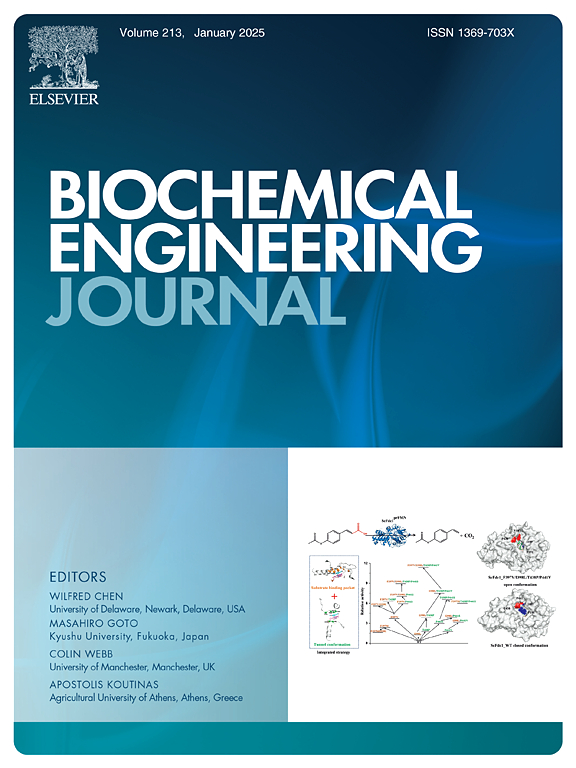A model based approach for monitoring Bordetella pertussis fermentation with an inline spectro-fluorescence probe
IF 3.7
3区 生物学
Q2 BIOTECHNOLOGY & APPLIED MICROBIOLOGY
引用次数: 0
Abstract
Presently, the extraction of the antigen pertactin poses a challenge in the manufacturing of the whooping cough vaccine due to its low and variable yield [1]. In this work, a hybrid model that combines empirical and mechanistic parts and in-line fluorescence measurements is used to design an estimator for monitoring the manufacturing process in bioreactors. The empirical part of the hybrid model uses Partial Least Squares (PLS) regression to estimate biomass, carbon source, and pertactin productivity from fluorescence data. In view that significant correlations are observed between oxidative stress and productivity, the mechanistic part of the hybrid model is based on key oxidative reaction pathways. Estimation based on a hybrid model is shown to improve the prediction accuracy of antigen productivity as compared to purely empirical or purely mechanistic model-based estimators. The proposed estimator enables real-time monitoring of the manufacturing process and opens the possibility of future implementation of mid-point corrective actions.
基于模型的在线荧光光谱探针监测百日咳杆菌发酵的方法
目前,百日咳疫苗中百日咳抗原perpern的提取因其产量低且不稳定而成为百日咳疫苗生产中的一个挑战。在这项工作中,结合了经验和机械部分和在线荧光测量的混合模型被用来设计一个用于监测生物反应器中制造过程的估计器。混合模型的经验部分使用偏最小二乘(PLS)回归来估计来自荧光数据的生物量,碳源和perpern生产力。鉴于氧化应激与生产力之间存在显著相关性,混合模型的机制部分基于关键的氧化反应途径。与纯粹的经验或纯粹的基于机制模型的估计器相比,基于混合模型的估计被证明可以提高抗原生产力的预测准确性。建议的估算器可以实时监控制造过程,并为将来实施中点纠正措施提供了可能性。
本文章由计算机程序翻译,如有差异,请以英文原文为准。
求助全文
约1分钟内获得全文
求助全文
来源期刊

Biochemical Engineering Journal
工程技术-工程:化工
CiteScore
7.10
自引率
5.10%
发文量
380
审稿时长
34 days
期刊介绍:
The Biochemical Engineering Journal aims to promote progress in the crucial chemical engineering aspects of the development of biological processes associated with everything from raw materials preparation to product recovery relevant to industries as diverse as medical/healthcare, industrial biotechnology, and environmental biotechnology.
The Journal welcomes full length original research papers, short communications, and review papers* in the following research fields:
Biocatalysis (enzyme or microbial) and biotransformations, including immobilized biocatalyst preparation and kinetics
Biosensors and Biodevices including biofabrication and novel fuel cell development
Bioseparations including scale-up and protein refolding/renaturation
Environmental Bioengineering including bioconversion, bioremediation, and microbial fuel cells
Bioreactor Systems including characterization, optimization and scale-up
Bioresources and Biorefinery Engineering including biomass conversion, biofuels, bioenergy, and optimization
Industrial Biotechnology including specialty chemicals, platform chemicals and neutraceuticals
Biomaterials and Tissue Engineering including bioartificial organs, cell encapsulation, and controlled release
Cell Culture Engineering (plant, animal or insect cells) including viral vectors, monoclonal antibodies, recombinant proteins, vaccines, and secondary metabolites
Cell Therapies and Stem Cells including pluripotent, mesenchymal and hematopoietic stem cells; immunotherapies; tissue-specific differentiation; and cryopreservation
Metabolic Engineering, Systems and Synthetic Biology including OMICS, bioinformatics, in silico biology, and metabolic flux analysis
Protein Engineering including enzyme engineering and directed evolution.
 求助内容:
求助内容: 应助结果提醒方式:
应助结果提醒方式:


